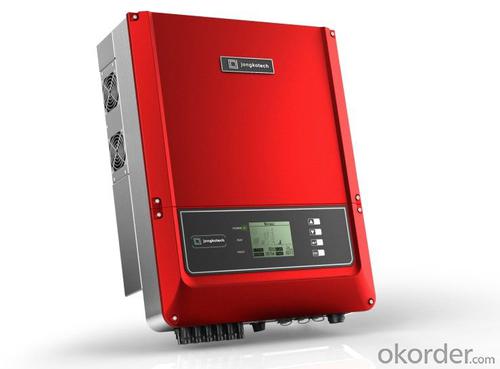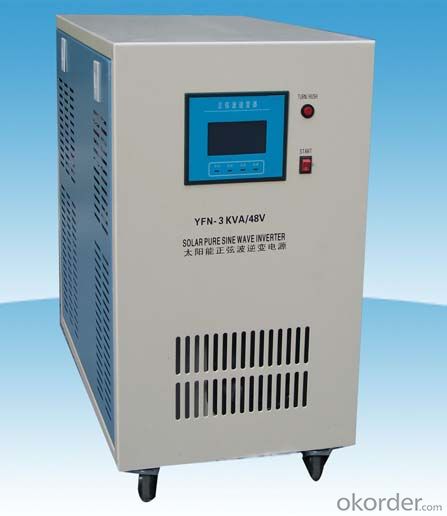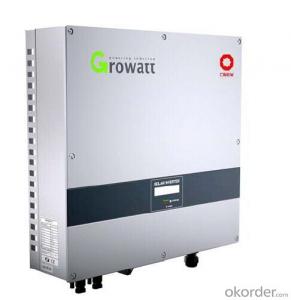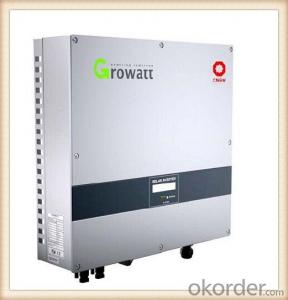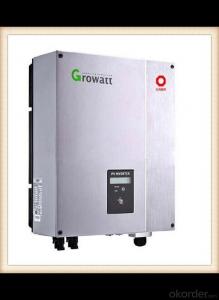3.6kW Hybrid Solar Inverter CNBM-H Hybrid Inverter
- Loading Port:
- Shanghai
- Payment Terms:
- TT OR LC
- Min Order Qty:
- 1000 watt
- Supply Capability:
- 100000000 watt/month
OKorder Service Pledge
OKorder Financial Service
You Might Also Like
1.Description of the Solar Inverter
2KW hybrid inverter
Pure sine wave output
Microprocessor controlled to guarantee stable charging system
Multiple operations: Grid tie , Off grid , and grid tie with backup
Built-in MPPT solar charger
LCD display panel for comprehensive information
Multiple communication
Green substitution for generators
User adhustable charging current up to 25A
2.Data sheet of the Solar Inverter
| Model | CNBM-H 2KW |
| Rated Power | 3000W |
| Grid-tie operation | |
| PV Input(DC) | |
| Maximum DC power | 3200W |
| Nominal DC voltage / Maximum DC voltage | 360 VDC/500 VDC |
| Start voltage /Initial Feeding Voltage | 116 VDC/150 VDC |
| MPP voltage range | 250 VDC ~ 450 VDC |
| Number of MPP Trackers/ Max input current | 1/1 X13A |
| GRID OUTPUT (AC) | |
| Nominal Output Voltage | 208/220/230/240 VAC |
| Output Voltage Range | 184 - 264.5 VAC |
| Nominal Output Current | 13.1A |
| Power Factor | >0.99 |
| EFFICIENCY | |
| Maximum Conversion Efficiency (DC/AC) | 96% |
| European Efficiency@ Vnominal | 95% |
| OFF-GRID OPERATION | |
| AC INPUT | |
| AC Startup Voltage /Auto Restart Voltage | 120 - 140 VAC / 85 VAC |
| Acceptable Input Voltage Range | 170 - 180 VAC |
| Maximum AC Input Current | 25A |
| PV INPUT (DC) | |
| Maximum DC Voltage | 500 VAC |
| MPP Voltage Range | 250 VAC~450 VAC |
| Maximum Input Current | 1/1 X13A |
| BATTERY MODE OUTPUT (AC) | |
| Nominal Output Voltage | 208/220/230/240 VAC |
| Output Frequency | 50HZ/60HZ(auto sensing) |
| Output Waveform | Pure sine wave |
| Efficiency (DC to AC) | 93% |
| HYBRID OPERATION | |
| PV INPUT (DC) | |
| Nominal DC voltage / Maximum DC voltage | 360 VDC/ 500 VDC |
| Start voltage /Initial Feeding Voltage | 116 VDC /150VDC |
| MPP voltage range | 250VDC ~450VDC |
| Maximum Input Current | 1/1 X13A |
| GRID OUTPUT (AC) | |
| Nominal Output Voltage | 208/220/230/240 VAC |
| Output Voltage Range | 184 ~264.5 VAC |
| Nominal Output Current | 13.1A |
| AC INPUT | |
| AC Startup Voltage /Auto Restart Voltage | 120 - 140 VAC /85 VAC |
| Acceptable Input Voltage Range | 170~ 180 VAC |
| Maximum AC Input Current | 25A |
| BATTERY MODE OUTPUT (AC) | |
| Nominal Output Voltage | 208/220/230/240 VAC |
| Efficiency (DC to AC) | 93% |
| BATTERY & CHARGER | |
| Nominal DC Voltage | 48VDC |
| Maximum Charging Current | 25A |
| GENERAL | |
| PHYSICAL | |
Dimension, D X W X H (mm) | 420x415x170 |
| Net Weight (kgs) | 15.5 |
| INTRRF ACE | |
| Communication Port | RS-232/USB |
| Intelligent Slot | Optional SNMP ,Modbus, and AS400 cards available |
| COMPLIANCE | |
| Standard | CE, VDE, 0216-1-1, VDE-AR-N 4105 |
3.Applications of the Solar Inverter
Inverter not only has direct communication transform function, but also has the maximum limit to carry on the function of the solar cell function and system fault maintenance function. In the aggregate, have active operation and shutdown function, maximum power tracking control function, prevent operation function alone (grid system use), the active voltage adjustment functions (grid system use), dc testing functions (grid system use), dc grounding detection function (grid system use)
4.IMages of the Solar Inverter
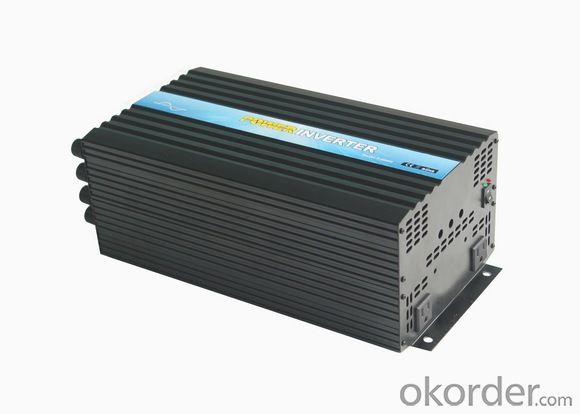
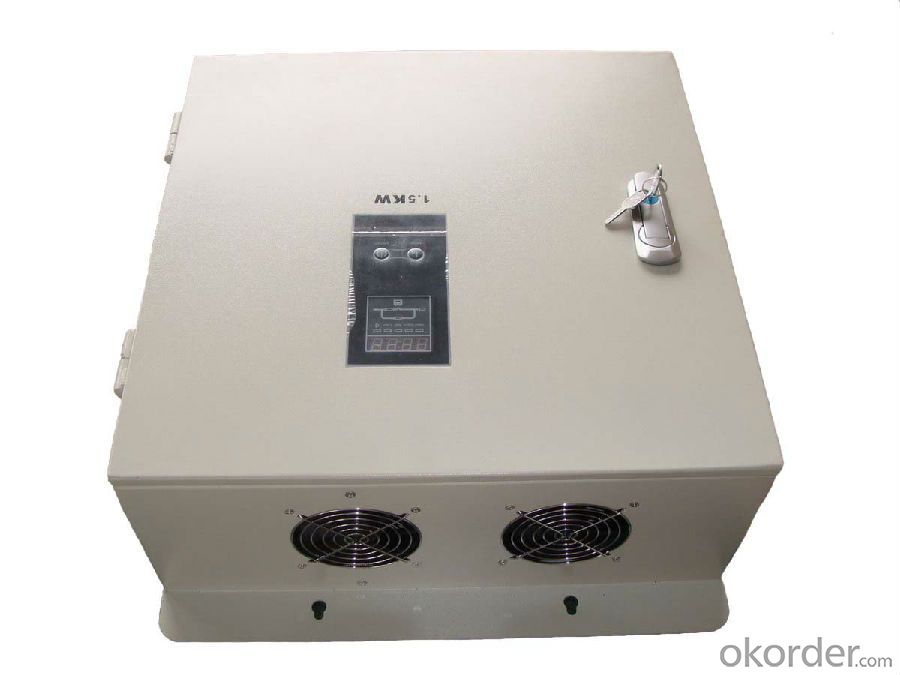
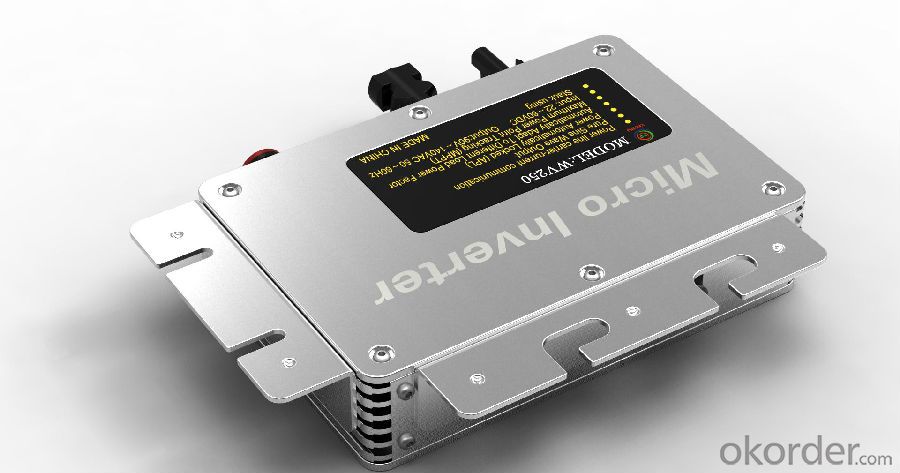
FAQ
Q: Do you have the CE, TUV, UL Certification?
A: We’ve already passed all the tests, and any certificate is available.
Q: Have you ever sold your products to companies in my country?
A: Of course, we have customers in all general PV markets, but I think we should expand our market share along with the market growth.
Q: When did your company set up? You are a new company, how can I believe your quality?
A: We entered into Solar PV industry in 2005, now we have several plants in manufacturing of a-Si and c-Si panels, and our capacity is 220MW per year. Till now we have already passed all the tests by authorized laboratories, e.g. TUV, CE, UL.
Q: Can you help us install the module if we cooperate with you?
A: We haven’t entered into installation sector, but we have the plan in near future.
Q: How do you pack your products?
A: We have rich experience on how to pack the panels to make sure the safety on shipment when it arrives at the destination.
Q: Can you do OEM for us?
A: Yes, we can.
Q: Can we visit your factory?
A: Surely, I will arrange the trip basing on your business schedule.
- Q: How does a solar inverter handle voltage regulation in the grid?
- A solar inverter regulates voltage in the grid by converting the DC power generated by the solar panels into AC power that matches the voltage and frequency of the grid. It monitors the grid's voltage level and adjusts the output accordingly to ensure a stable and consistent supply of power. Additionally, it also helps in maintaining power quality by maintaining the grid's voltage within the specified range and compensating for fluctuations or variations in voltage levels.
- Q: Are there any electromagnetic interference concerns associated with solar inverters?
- Solar inverters come with electromagnetic interference (EMI) concerns. They convert the direct current (DC) produced by solar panels into alternating current (AC) for powering homes and businesses. This conversion process involves high frequency switching, which can generate EMI. EMI refers to the disturbance caused by electromagnetic radiation emitted by electronic devices. It can interfere with the proper functioning of nearby electronic devices. In the case of solar inverters, the EMI generated can potentially impact radios, televisions, and communication systems. To address these concerns, solar inverter manufacturers typically comply with relevant EMI standards and regulations. This may involve limiting the amount of electromagnetic radiation emitted by the inverters and using shielding materials to reduce EMI. Some inverters also incorporate filters or other techniques to suppress EMI and minimize interference. When selecting and positioning solar inverters, solar installers and system designers should consider EMI concerns. Proper installation and grounding techniques can help decrease EMI issues. It is also important to follow local regulations and guidelines to ensure compliance with EMI standards and minimize potential interference with other electronic devices. Overall, although EMI concerns exist with solar inverters, proper design, installation, and adherence to relevant standards can effectively mitigate these concerns. This ensures the smooth operation of both the solar system and other electronic equipment in the area.
- Q: Can a solar inverter be used with bifacial solar panels?
- Yes, a solar inverter can be used with bifacial solar panels. Bifacial solar panels have the ability to capture sunlight from both sides, making them more efficient. A solar inverter is responsible for converting the DC power generated by solar panels into usable AC power for homes or businesses. Therefore, it can easily be used with bifacial solar panels to ensure efficient power conversion and utilization.
- Q: Can a solar inverter be used in a commercial solar system?
- Yes, a solar inverter can definitely be used in a commercial solar system. In fact, solar inverters are an essential component in converting the direct current (DC) electricity generated by solar panels into alternating current (AC) electricity that is compatible with the electrical grid and can be used by commercial buildings and businesses.
- Q: What is the maximum power output of a residential solar inverter?
- The maximum power output of a residential solar inverter can vary depending on the specific model and capacity. However, on average, residential solar inverters typically have a maximum power output ranging from 3 kilowatts (kW) to 10 kW.
- Q: How does a solar inverter handle voltage fluctuation during cloud cover?
- A solar inverter handles voltage fluctuation during cloud cover by continuously monitoring the output voltage of the solar panels. When cloud cover causes a decrease in sunlight and therefore a drop in voltage, the inverter adjusts its operation to maintain a stable output voltage. It does this by employing various techniques such as maximum power point tracking (MPPT) to optimize power generation, and voltage regulation to ensure the output voltage remains within the desired range. This helps to minimize the impact of voltage fluctuations and ensure the solar system continues to operate efficiently even during cloud cover.
- Q: What is the standby power consumption of a solar inverter?
- The standby power consumption of a solar inverter refers to the amount of power it consumes when it is not actively converting solar energy into usable electricity. This power consumption is typically very low, often ranging from a few watts to a few tens of watts, depending on the model and efficiency of the inverter.
- Q: How do you calculate the maximum power point tracking range for a solar inverter?
- To calculate the maximum power point tracking (MPPT) range for a solar inverter, you need to consider various factors such as the solar panel's voltage and current characteristics, temperature, and the inverter's efficiency. Using the voltage-current (V-I) curve of the solar panel, the MPPT range can be determined by finding the point where the power output is maximized. This is typically done using algorithms within the solar inverter to continuously adjust the operating point to track the maximum power available from the solar panel.
- Q: What is the role of a solar inverter in a battery storage system?
- The role of a solar inverter in a battery storage system is to convert the direct current (DC) electricity produced by the solar panels into alternating current (AC) electricity that can be used to power household appliances and charge the battery. It also manages the flow of electricity between the solar panels, battery, and the grid, ensuring optimal utilization of the stored energy and facilitating grid interaction when necessary.
- Q: Can a solar inverter be used with a portable solar panel system?
- Yes, a solar inverter can be used with a portable solar panel system. The solar inverter converts the direct current (DC) generated by the portable solar panels into alternating current (AC) that can be used to power various devices or be fed into the electrical grid. This allows for the efficient utilization of the energy generated by the portable solar panel system.
Send your message to us
3.6kW Hybrid Solar Inverter CNBM-H Hybrid Inverter
- Loading Port:
- Shanghai
- Payment Terms:
- TT OR LC
- Min Order Qty:
- 1000 watt
- Supply Capability:
- 100000000 watt/month
OKorder Service Pledge
OKorder Financial Service
Similar products
Hot products
Hot Searches
Related keywords






